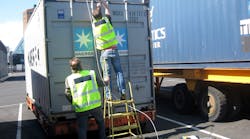Making trains run on time has been a benchmark for management efficiency since Italian dictator Benito Mussolini took credit for that feat during World War II. So the timing of BNSF’s announcement this week that it was contemplating a switch from diesel to natural gas might end up being unfortunate.
That’s because at about the same time news came out about this railroad’s contemplated adoption of a locomotive that can run on liquefied natural gas—something its CEO Matt Rose said could rank right up there with the industry’s transition away from steam—someone else came out with news that might take some steam out of that assessment.
The Environmental Defense Fund announced it is sponsoring a study by the Center for Alternative Fuels, Engines and Emissions (CAFEE) at West Virginia University to measure fugitive emissions of methane, a powerful greenhouse gas associated with routine operation of fleet vehicles fueled by compressed or liquefied natural gas.
The goal is to better understand methane leakage associated with natural gas vehicles and fueling stations. Sure, natural gas is a cleaner-burning fossil fuel than diesel and it’s a lot cheaper, but here’s the big BUT: these researchers say methane released into the atmosphere could accelerate climate change.
These “fugitive emissions” of natural gas can happen all along the natural gas supply chain, and if they’re not controlled, a natural gas engine could do more environmental damage than diesel, according to Fred Krupp, president of EDF. In fact, he says if any more than one percent of the methane produced in the natural gas supply chain gets into the environment, the fuel’s costs will have already outweighed its benefits.
But here’s the funny thing about environmental regulations that result from a study like this: other regulations. New EPA air pollution standards will require railroads to add expensive emission-control equipment to new diesel locomotives in 2015. So you can see why BNSF is so gung ho about making the case for natural gas. It’s working with General Electric and Caterpillar on this initiative, and their preliminary tests show that LNG can take trains farther than diesel without sacrificing power. No word if they’ll be looking at how much methane is sacrificed to the air.
That’s the scope of EDF’s project, and they’ll be working with some pretty powerful co-sponsors too, including the American Gas Association, International Council on Clean Transportation, PepsiCo, Shell, Volvo Group, Waste Management, Cummins Westport and Westport Innovations. These partners are providing access to vehicles, facilities, and equipment for testing. The study will measure methane emissions at CNG and LNG refueling sites and maintenance facilities. Results are expected to be released in a peer-reviewed journal by late 2013 or early 2014.
If those results stink, that’ll leave the railroads only a year to come up with another alternative to diesel. That may be a tough timetable to meet—even for them.



